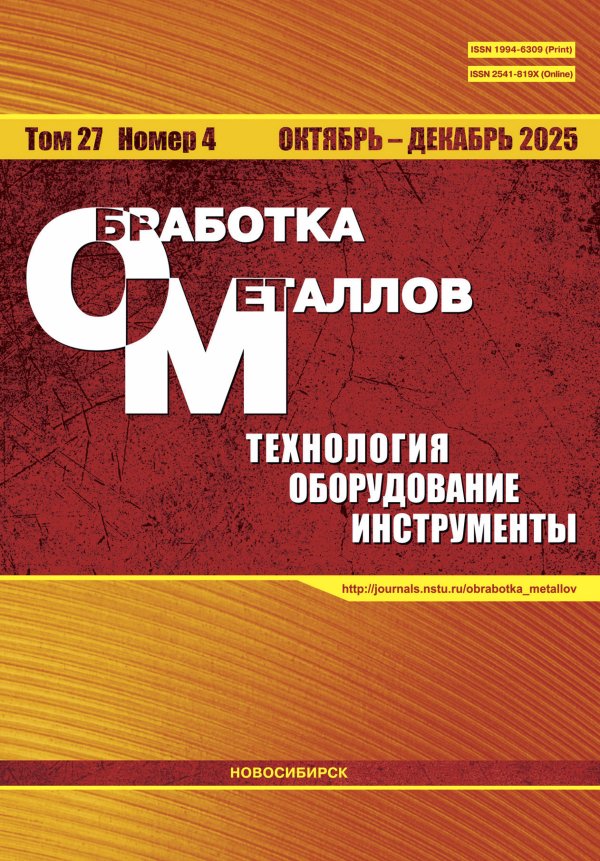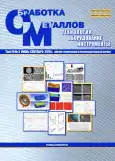Улучшение антикоррозионных и триботехнических свойств сплава Ti6Al4V осаждением электроискровых Ti-Al-Si-C покрытий
- Авторы: Бурков А.А.1, Пячин С.А.1, Власова Н.М.1, Астапов И.А.1, Кулик М.А.1
-
Учреждения:
- Выпуск: Том 20, № 3 (2018)
- Страницы: 85-96
- Раздел: МАТЕРИАЛОВЕДЕНИЕ
- URL: https://bakhtiniada.ru/1994-6309/article/view/302081
- DOI: https://doi.org/10.17212/1994-6309-2018-20.3-85-96
- ID: 302081
Цитировать
Полный текст
Аннотация
Ключевые слова
Об авторах
А. А. Бурков
Email: burkovalex@mail.ru
кандидат физико-математических наук; Институт материаловедения Хабаровского научного центра ДВО РАН, ул. Тихоокеанская, 153, г. Хабаровск, 680042, Россия; burkovalex@mail.ru
С. А. Пячин
Email: pyachin@mail.ru
кандидат физико-математических наук, доцент; Институт материаловедения Хабаровского научного центра ДВО РАН, ул. Тихоокеанская, 153, г. Хабаровск, 680042, Россия; pyachin@mail.ru
Н. М. Власова
Email: vlasova64@yandex.ru
кандидат технических наук; Институт материаловедения Хабаровского научного центра ДВО РАН, ул. Тихоокеанская, 153, г. Хабаровск, 680042, Россия; vlasova64@yandex.ru
И. А. Астапов
Email: immaterial_khv@mail.ru
кандидат физико-математических наук; Институт материаловедения Хабаровского научного центра ДВО РАН, ул. Тихоокеанская, 153, г. Хабаровск, 680042, Россия; immaterial_khv@mail.ru
М. А. Кулик
Email: marijka80@mail.ru
Институт материаловедения Хабаровского научного центра ДВО РАН, ул. Тихоокеанская, 153, г. Хабаровск, 680042, Россия; marijka80@mail.ru
Список литературы
- Ganjeh E., Sarkhosh H. Microstructural, mechanical and fractographical study of titanium-CP and Ti–6Al–4V similar brazing with Ti-based filler // Materials Science and Engineering A. – 2013. – Vol. 559. – P. 119–129. – doi: 10.1016/j.msea.2012.08.043.
- Joining of zirconia and Ti6Al4V using a Ti-based amorphous filler / Y.H. Liu, J.D. Hu, Y.P. Zhang, Z.X. Guo, Y. Yang // Journal of Materials Science and Technology. – 2007. – Vol. 27. – P. 4983–4993. – doi: 10.1016/S1005-0302(11)60121-7.
- Oxidation behaviour of plasma surface alloying on Ti6Al4V alloy / D.-B. Wei, P.-Z. Zhang, Z.-J. Yao, X.-F. Wei, J.-T. Zhou, X.-H. Chen // Surface Engineering. – 2018. – Vol. 34. – P. 14–21. – doi: 10.1179/1743294415Y.0000000095.
- Martini C., Ceschini L. A comparative study of the tribological behaviour of PVD coatings on the Ti–6Al–4V alloy // Tribology International. – 2011. – Vol. 44. – P. 297–308. – doi: 10.1016/j.triboint.2010.10.031.
- Optimizing the tribological behavior of tantalum carbide coating for the bearing in total hip joint replacement / S. Du, K. Zhang, M. Wen, Y. Qin, R. Li, H. Jin, X. Bao, P. Ren, W. Zheng // Vacuum. – 2018. – Vol. 150. – P. 222–231. – doi: 10.1016/j.vacuum.2018.01.050.
- Effect of CeO2 on microstructure and wear resistance of TiC bioinert coatings on Ti6Al4V alloy by laser cladding / T. Chen, D. Liu, F. Wu, H. Wang // Materials. – 2018. – Vol. 11, iss 1. – P. 1–14. – doi: 10.3390/ma11010058.
- Structure and tribological properties of TiSiCN coating on Ti6Al4V by arc ion plating / J. Li, Y. Wang, Y. Yao, Y. Wang, L. Wang // Thin Solid Films. – 2017. – Vol. 644. – P. 115–119. – doi: 10.1016/j.tsf.2017.09.053.
- Synthesis and characterization of Ni60-hBN high temperature self-lubricating anti-wear composite coatings on Ti6Al4V alloy by laser cladding / X.-L. Lu, X.-B. Liu, P.-C. Yu, S.-J. Qiao, Y.-J. Zhai, M.-D. Wang, Y. Chen, D. Xu // Optics & Laser Technology. – 2016. – Vol. 78. – P. 87–94. – doi: 10.1016/j.optlastec.2015.10.005.
- Structure and tribological behavior of GLCH/nitride coupled coatings on Ti6Al4V by nitriding and magnetron sputtering / R. Niu, J. Li, Y. Wang, J. Chen, Q. Xue // Diamond & Related Materials. – 2016. – Vol. 64. – P. 70–79. – doi: 10.1016/j.diamond.2016.01.015.
- Compositions and tribological properties of PEO coatings on Ti6Al4V alloy / Y.K. Qin, D.S. Xiong, J.L. Li, R. Tyagi // Surface Engineering. – 2017. – Vol. 33. – P. 895–902. – doi: 10.1179/1743294414Y.0000000412.
- Plasma-sprayed Ti6Al4V alloy composite coatings reinforced with in situ formed TiB-TiN / A. Anand, M. Das, B. Kundu, V.K. Balla, S. Bodhak, S. Gangadharan // Journal of Thermal Spray Technology. – 2017. – Vol. 26. – P. 2013–2019. – doi: 10.1007/s11666-017-0651-5.
- Characterization of microstructure and wear resistance of PEO coatings containing various microparticles on Ti6Al4V alloy / X. Li, C. Dong, Q. Zhao, Y. Pang, F. Cheng, S. Wang // Journal of Materials Engineering and Performance. – 2018. – Vol. 27. – P. 1642–1653. – doi: 10.1007/s11665-018-3249-2.
- Effect of heat treatment on residual stress and wear behaviors of the TiNi/Ti2Ni based laser cladding composite coatings / Y.-F. Tao, J. Li, Y.-H. Lv, L.-F. Hu // Optics and Laser Technology. – 2017. – Vol. 97. – P. 379–389. – doi: 10.1016/j.optlastec.2017.07.029.
- Tribological properties in seawater for Ti/TiCN coatings on Ti6Al4V alloy by arc ion plating with different carbon contents / J.-L. Li, G.-Y. Cai, H.-S. Zhong, Y.-X. Wang, J.-M. Chen // Rare Metals. – 2016. – Vol. 36. – P. 858–864. – doi: 10.1007/s12598-016-0802-8.
- In-situ integrated fabrication of Ti–Ni coating during hot isostatic pressing of Ti6Al4V parts: Microstructure and tribological behavior / C. Cai, B. Song, Q. Wei, P. Xue, S. Wen, J. Liu, Y. Shi // Surface and Coatings Technology. – 2015. – Vol. 280. – P. 194–200. – doi: 10.1016/j.surfcoat.2015.09.007.
- Characterizations of anodic oxide films formed on Ti6Al4V in the silicate electrolyte with sodium polyacrylate as an additive / J. Wang, Y. Ma, J. Guan, D. Zhang // Surface and Coatings Technology. – 2018. – Vol. 338. – P. 14–21. – doi: 10.1016/j.surfcoat.2018.01.076.
- Plasma nitriding of Ti6Al4V alloy and AISIM2 steel substrates using D.C. glow discharges under a triode configuration / J.C. Avelar-Batista, E. Spain, J. Housden, A. Matthews, G.G. Fuentes // Surface and Coatings Technology. – 2005. – Vol. 200. – P. 1954–1961. – doi: 10.1016/j.surfcoat.2005.08.037.
- Rapid preparation of TiC reinforced Ti6Al4V based composites by carburizing method through spark plasma sintering technique / Y.J. Hao, J.X. Liu, J.C. Li, S.K. Li, Q.H. Zou, X.W. Chen // Materials & Design. – 2015. – Vol. 65. – P. 94–97. – doi: 10.1016/j.matdes.2014.09.008.
- Influence of different plasma nitriding treatments on the wear and crack behavior of forging tools evaluated by Rockwell indentation and scratch tests / Z.K. Chang, X.S. Wan, Z.L. Pei, J. Gong, C. Sun // Surface and Coatings Technology. – 2011. – Vol. 205. – P. 4690–4696. – doi: 10.1016/j.surfcoat.2010.07.053.
- Characterization of Ti–C–N coatings deposited on Ti6Al4V for biomedical applications / V.S. Viteri, M.G. Barandika, U.R. Gopegui, R. Bayón, C. Zubizarreta, X. Fernández, A. Igartua // Journal of Inorganic Biochemistry. – 2012. – Vol. 117. – P. 359–366. – doi: 10.1016/j.jinorgbio.2012.09.012.
- Microstructure and properties of titanium aluminides on Ti6Al4V titanium alloy produced by chemical vapor deposition method / R. Sitek, J. Kaminski, J. Borysiuk, H. Matysiak, K. Kubiak, K.J. Kurzydlowski // Intermetallics. – 2013. – Vol. 36. – P. 36–44. – doi: 10.1016/j.intermet.2012.12.017.
- Исследование износостойкости и жаростойкости электроискровых Ti-Al-покрытий на титановом сплаве / С.А. Пячин, А.А. Бурков, Т.Б. Ершова, Н.М. Власова, М.А. Теслина, Е.Р. Зайкова // Заготовительные производства в машиностроении. – 2016. – № 8. – С. 37–44.
- Preparation and microstructure of CuNiTiZr medium-entropy alloy coatings on TC11 substrate via electrospark – computer numerical control deposition process / X.-R. Wang, Z.-Q. Wang, W.-S. Li, T.-S. Lin, P. He, C.-H. Tong // Materials Letters. – 2017. – Vol. 197. – P. 143–145. – doi: 10.1016/j.matlet.2017.03.109.
- Leyens C., Peters M., Kaysser W.A. Intermetallic Ti-Al coatings for protection of titanium alloys: oxidation and mechanical behavior // Surface and Coatings Technology. – 1997. – Vol. 94–95. – P. 34–40. – doi: 10.1016/S0257-8972(97)00472-6.
- The use of titanium aluminides to form electric-spark coatings / S.A. Pyachin, T.B. Ershova, A.A. Burkov, N.M. Vlasova, V.S. Komarova // Russian Journal of Non-Ferrous Metals. – 2016. – Vol. 57, – P. 266–272. – doi: 10.3103/S1067821216030135.
- Верхотуров А.Д. Физико-химические основы процесса электроискрового легирования металлических поверхностей. – Владивосток: Дальнаука, 1992. – 180 с.
- Влияние добавок оксидов и карбидов металлов на свойства интерметаллидных Ti3Al электроискровых покрытий / С.А. Пячин, А.А. Бурков, Н.М. Власова, Е.А. Кириченко // Фундаментальные проблемы современного материаловедения. – 2016. – Т. 13, № 2. – С. 168–173.
- Kofstad P., Hauffe K., Kjöllesdal H. Investigation on the oxidation mechanism of titanium // Acta Chemica Scandinavica. – 1958. – Vol. 12. – P. 239–266.
Дополнительные файлы







